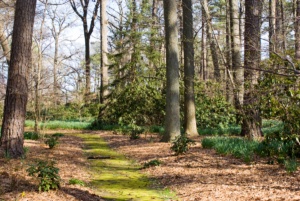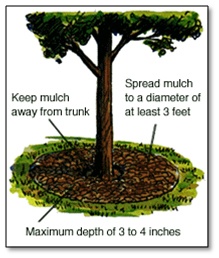Monthly Archives:
How to Mulch Your Trees the Right Way
There’s a right way and a wrong way to apply mulch to the trees on your property. As with everything in life, spending a little extra time to do it the right way will give you much better results.
The New Jersey certified arborists here at Friendly Tree understand the issues urban trees face, and we work diligently to mitigate these issues for a healthy, happy landscape.
Lessons From Nature
 Next time you take a stroll through your favorite wooded trail, take a moment to look at the forest floor. Trees are naturally blanketed by a layer of leaves and other organic material which help to retain moisture, suppress weeds, regulate soil temperature and replenish essential nutrients.
Next time you take a stroll through your favorite wooded trail, take a moment to look at the forest floor. Trees are naturally blanketed by a layer of leaves and other organic material which help to retain moisture, suppress weeds, regulate soil temperature and replenish essential nutrients.
The best way to mulch trees in an urban landscape is to mimic their natural environment as closely as possible.
The Do’s and Don’ts of Mulching
Do:
- Apply mulch in the Spring once the ground has thawed, or after planting.
- Ensure proper soil drainage before mulching. Use less mulch if the tree is in a poorly drained area.
- Clear a 3-10 foot circle around the base of the tree, free from grass, rocks or debris. DO NOT spray an herbicide, like Roundup, to kill the grass.
- Before mulching, spread compost within the circle and water thoroughly.
- Choose a natural mulch material such as hardwood chips, hardwood or softwood bark, composted leaves, straw or pine needles. Inorganic mulch (such as pulverized rubber) won’t supply nutrients or improve soil structure.
- Layer mulch 2-4 inches deep above the compost.
- Use a rake to spread the mulch evenly out to the edge of the circle, making sure excess mulch isn’t piled up against the trunk of the tree.
Don’t:
- Spread mulch up to the tree’s trunk; this is known as volcano mulching and can eventually kill your tree!
 Keep mulch away from the tree’s root flare, which is where the roots begin and the trunk ends.
Keep mulch away from the tree’s root flare, which is where the roots begin and the trunk ends. - Use compost or mulch that is too “hot,” which simply means it hasn’t had adequate time to break down and decompose (like fresh manure or fresh grass clippings).
- Apply mulch too deep, which can cause root rot in wet soils.
- Use fine mulch, which can limit the penetration of air and water as it becomes compacted.
- Mulch right before the ground freezes, which creates an ideal shelter for rodents and pests looking for a warm winter hideaway.
Mulch is a Tree’s Best Friend
Mulch is essential to the health and vitality of the trees on your property, and the benefits far outweigh the cost and time invested. In fact, it’s one of the most important practices for optimal tree health. In urban landscapes, where trees may not naturally grow, it’s important to provide a rich, protected soil environment similar to their natural growing conditions.
Proper mulching:
- Helps trees conserve moisture, which also means less watering and lower water bills.
- Prevents weed growth and competition.
- Regulates and insulates soil temperature, protecting roots from extreme heat and cold.
- Reduces trees’ susceptibility to diseases.
- Helps to prevent soil compaction around tree roots.
- Protects trees from lawn mower or weed whacker damage.
- Improves soil structure, aeration and drainage.
- Enhances soil fertility, providing nutrients and microorganisms essential to tree growth.
- Provides a uniform, aesthetically pleasing look to the landscape.
How Much Mulch Do You Need?
Now that you know the proper way to mulch your trees, exactly how much mulch will you need?
The easiest way to determine that is to use our mulch calculator, which tells you how many cubic yards of mulch you will need per tree (or garden bed).
Or, simply give us a call and we can help you determine what kind and how much mulch you need for your property. With 26 years in the business, there is no other company in New Jersey that knows more about tree health. At Friendly Tree, we pride ourselves on providing expert, reliable service, taking the utmost care of our customers and their trees.
Recent Posts
Archives
- August 2022
- June 2022
- May 2022
- April 2022
- March 2022
- February 2022
- January 2022
- December 2021
- November 2021
- September 2021
- August 2021
- July 2021
- June 2021
- April 2021
- March 2021
- February 2021
- January 2021
- December 2020
- November 2020
- October 2020
- September 2020
- August 2020
- July 2020
- June 2020
- May 2020
- April 2020
- January 2020
- December 2019
- November 2019
- October 2019
- September 2019
- August 2019
- July 2019
- June 2019
- May 2019
- April 2019
- March 2019
- February 2019
- November 2018
- September 2018
- August 2018
- July 2018
- June 2018
- May 2018
- April 2018
- February 2018
- September 2016
- August 2016
- July 2016
- June 2016
- May 2016
- April 2016
- November 2015
- August 2015
- March 2015



Recent Comments